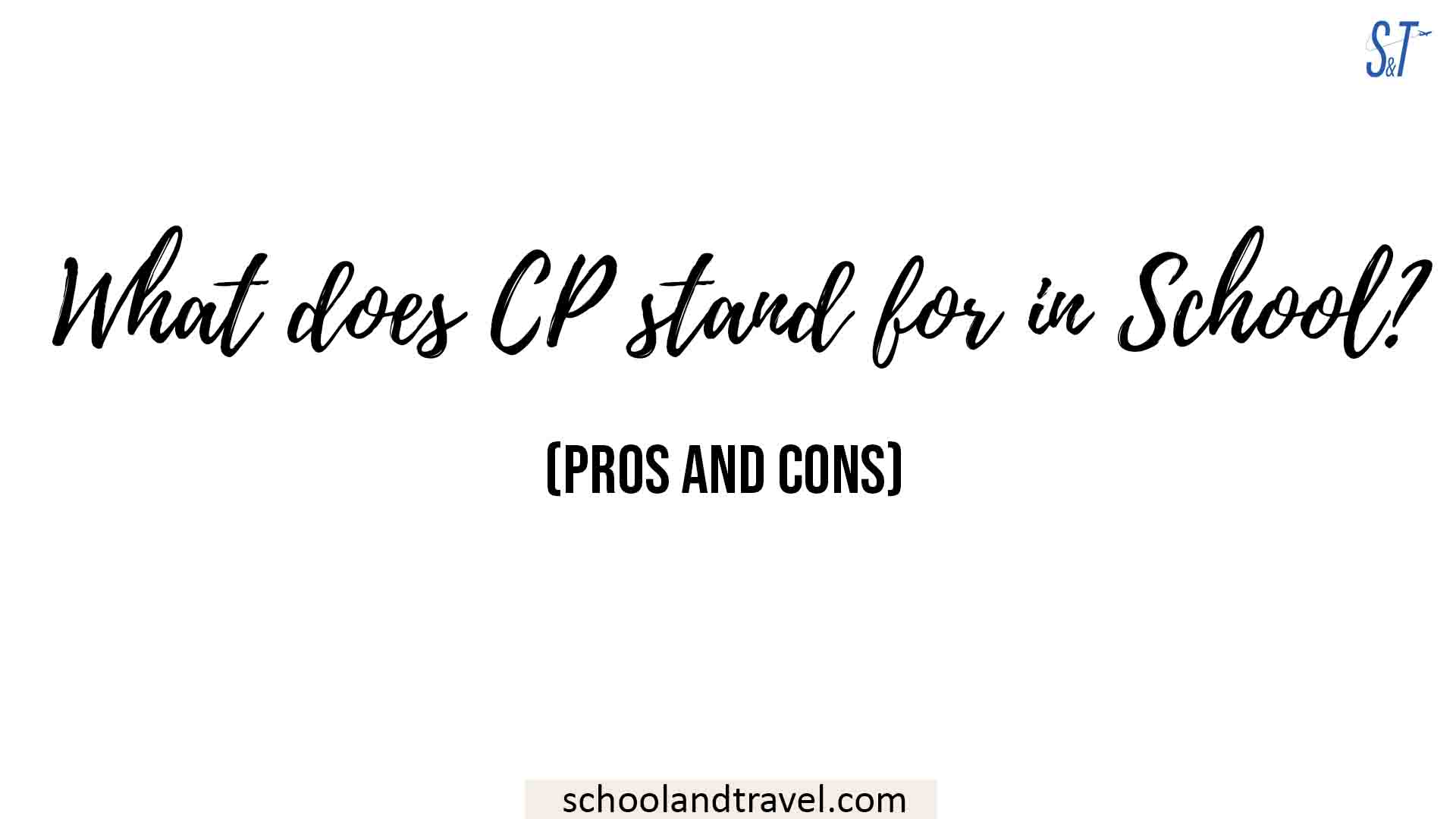In our previous article, we answered the question, “What does AP stand for in School?” This article will answer the question, “What does CP stand for in school?”.
AP and CP are often interchanged in meaning, but one is the opposite of the other.
What does CP Stand For in School?
CP stands for “College Preparatory”. In High school, CP classes prepare an aspiring college student for college life and the associated educational activities.
The program is directed by college advisors who help in decision-making during college applications and seek financial aid.
Some schools see CP classes as preparatory classes that come with the workload, projects, and homework to help a student understand what college life feels like and the stress associated with it.
Some schools go to the length of setting up a curriculum and providing lectures and instructions using college standards and principles.
Read this: What is a Transcript? (Quick and Easy answer)
What does CP Mean in Middle School?
When discussing middle school, “CP” usually means “College Preparatory.” However, middle school classes are less likely to be labeled “college preparatory” than high school classes.
If you see the abbreviation “CP” in a middle school setting and it doesn’t seem to fit the “College Preparatory” context, you might want to ask a school official or teacher what it means since abbreviations can have different meanings based on the situation or region.
What does CP Stand For in School? (Educational Context)
1. College Preparatory:
These high school courses are specifically designed to prepare students for the rigorous demands of college-level work.
College Prep classes often go more in-depth than regular courses, emphasizing critical thinking, writing skills, and complex problem-solving.
They may also include preparatory work for standardized tests like the SAT or ACT. Participation in CP classes can also be viewed favorably during the college application process.
2. Child Protection:
Many schools have child protection units or policies in place. These are designed to safeguard children from any potential harm, including physical, emotional, and sexual abuse.
Schools have a responsibility to protect students from harm. This could be in the form of physical, emotional, or sexual abuse.
Teachers and staff are usually trained to recognize potential signs of abuse and to follow specific reporting procedures.
3. Continuation Program:
These are alternative education settings for students who might not succeed in the typical school system due to behavioral issues, academic challenges, or other reasons.
They provide a structured environment where students can earn credits toward graduation.
Continuation programs often offer flexible schedules, different teaching methodologies, or specialized support to help students who might be at risk of dropping out.
4. Continuing Professional (Development or Education):
Educators, like many professionals, often have requirements to continue their learning. This could be through workshops, courses, or conferences.
These opportunities allow educators to stay updated on best practices, new research, and innovative teaching strategies.
Like other professionals, teachers need to stay updated with the latest research, methodologies, and tools in education.
Many jurisdictions or school districts may require teachers to earn certain professional development hours or credits annually.
5. Class Participation:
In many classes, especially higher education, students are graded not just on tests and assignments but also on how actively they participate in class discussions.
This encourages students to engage with the material actively and contribute to class discussions.
Students’ grades may be influenced by their participation level in some classes. Active participation can indicate a student’s engagement and understanding of the material.
6. Class Period:
Many school systems divide the day into class periods, each dedicated to a different subject or course. For instance, a student might have English in the first period, Math in the second period, etc.
In many schools, the day is divided into multiple periods, each of which might be 45 minutes, an hour, or even longer, and is dedicated to a particular class like Math, English, or Science.
7. Checkpoint:
Educators might institute checkpoints or smaller assessments, especially in larger courses or modules, to ensure students grasp the material.
These are not necessarily major exams but could be quizzes or projects that help the teacher and student understand where the student stands regarding comprehension.
What does CP mean in College?
1. College Preparatory:
While this is more commonly associated with high school courses designed to prepare students for college-level work, it could also be used in a college setting for courses intended to prepare students for advanced studies or graduate-level work.
2. Continuing Professional (or Professional Education):
This refers to courses or training that college professionals or graduates might take to continue their education or earn professional development credits.
3. Credit Points:
Some colleges might use “CP” to denote credit points, which indicate the value or weight of a particular course in the curriculum.
4. Course Pack:
A collection of reading materials or resources curated specifically for a particular college course.
5. Computer Programming:
In some contexts, especially within technical or computer science departments, “CP” could be shorthand for computer programming.
6. Course Placement:
This refers to placing students into courses appropriate for their skill level, especially in subjects like mathematics or languages.
7. Clinical Placement:
Often used in medical, nursing, or allied health programs, it refers to assigning students to specific clinical settings for hands-on training.
8. Collaborative Project:
Within certain courses or programs, students might engage in collaborative projects (CP) where teamwork and interdisciplinary skills are emphasized.
9. Capstone Project:
In some degree programs, students must complete a capstone project (sometimes called CP) that culminates their learning experience, often during their final year.
10. Course Professor:
While less common, “CP” might be used in some settings as an abbreviation for “course professor,” referring to the lead instructor or professor for a specific course.
11. Curriculum Planning:
“CP” might refer to planning or designing a curriculum in academic administration or counseling.
12. Cultural Programs:
Colleges often host or offer various cultural programs to enrich the student experience and promote cultural diversity and awareness.
What does CP mean on Transcripts?
On transcripts, especially in educational grading, “CP” often stands for “College Preparatory.”
A course designated as “CP” is a college preparatory course, suggesting that it is designed to prepare students for the academic demands of college.
These courses are typically more rigorous than standard high school courses but less advanced than honors or Advanced Placement (AP) courses.
However, it’s essential to remember that transcript abbreviations can vary by institution, district, state, or country.
If you’re looking at a specific transcript and are unsure of “CP” or any other abbreviation, it’s always best to consult the school’s registrar or administration for clarification.
What does CP mean in Baseball?
In baseball, “CP” means “Closer Pitcher.” The player pitches at the end of the game to help their team secure a win.
What does CP mean on Report Card?
In simple words, on a report card, “CP” usually means “College Preparatory,” indicating the course prepares students for college-level work.
What are CP Classes?
CP Classes, standing for “College Preparatory,” are high school courses designed to prepare students for the demands and rigor of college-level work.
Are CP Classes Worth It?
CP (College Preparatory) classes are designed to get students ready for college-level work. Whether they’re worth it depends on a student’s goals:
- Yes, they’re worth it if:
- You plan to go to college and want to be well-prepared.
- You’re looking for more challenging coursework in high school.
- You want to improve your college application.
- Maybe not, if:
- You feel too stressed or overwhelmed with the workload.
- You have other commitments and can’t manage the time.
- You’re more interested in vocational or hands-on learning.
Pros and Cons of CP Classes
| Pros | Cons |
|---|---|
| Diverse Curriculum: Offers a well-rounded education that touches upon multiple subjects essential for college readiness. | Potential Burnout: Continuous exposure to an intensive curriculum without breaks can lead to student burnout. |
| Structured Guidance: Provides students with structured guidance and resources to navigate college applications and requirements. | Not Suitable for Everyone: Some students may thrive better in vocational or technical courses rather than a college-prep curriculum. |
| Collaborative Environment: Encourages group projects and discussions, promoting teamwork and communication skills. | Competitive Atmosphere: The drive to outperform peers might create an overly competitive atmosphere, potentially affecting mental well-being. |
| Preparation for Standardized Tests: Often aligns with materials covered in SATs, ACTs, etc., helping students prepare for these tests. | Less Flexibility: The structured nature of CP courses might offer less flexibility in exploring unconventional learning paths or topics. |
| Builds Academic Discipline: Cultivates habits like time management, organization, and study strategies essential for college success. | Financial Strain: CP courses might come with costs for materials, tutoring, or special programs, which could be a burden for some families. |
FAQs on the Meaning Of CP in School
In the context of school, “CP” typically stands for “College Preparatory.” It refers to courses that prepare students for college-level work.
Yes, CP (College Preparatory) classes often delve deeper into subjects and are designed to be more rigorous to prepare students for the academic demands of college.
While CP classes can showcase a student’s willingness to take on challenges, colleges consider various factors during admissions. However, CP classes can positively impact a student’s application by demonstrating readiness for college-level work.
Not necessarily. While CP classes can enhance an application, colleges look at a holistic view of students, considering factors like extracurricular activities, recommendation letters, essays, and more. Choosing a class load that aligns with your capabilities and aspirations is important.
“CP English” typically stands for “College Preparatory English.” It refers to an English course designed to prepare students for the academic demands they’ll encounter in college. The course typically covers reading, writing, and analytical skills at a level that aims to transition students smoothly into college-level English courses.
Conclusion
CP classes can benefit students aiming for college or those who thrive on academic challenges.
However, it’s crucial to balance ambition with well-being and consider what aligns best with your future plans and current circumstances.
Talking to guidance counselors, teachers, or older students can also offer insights into making the right choice.
Awesome one; I hope this article answers your question.
Editor’s Recommendations:
- Do College Dorms Allow Reptiles? (Yes/No, FAQs)
- 19+ Social Development Strengths and Weaknesses List (FAQs)
- Can Teachers Have Tattoos? (UK, US, Canada, Tips, FAQs)
- How to Balance Relationships and Studies (Tips, Reasons, FAQs)
- Are Honorary Degrees Stupid? (Yes/no, Reasons, FAQs)
- 5 Major Similarities Between Management and Administration
If you find this article good, please share it with a friend.






